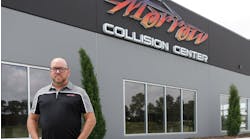Content brought to you by ABRN. To subscribe, click here.
What you will learn:
- Why it's important to talk with, not to, your customer
- How walking the customer through the repair process will help you explain the steps involved in repairing their vehicle and answer any questions they might have
- The final inspection helps include the customer as an ally by including them in the claims, parts and repair processes will reduce conflict that often occurs because of miscommunication.
As we work through the trials of running a collision repair business, we often forget the most important ally: the vehicle owner or customer. It’s not that we ignore them, since we do talk to them and tell them what we think we they need to know. We just don’t talk with them. Trust me, there is a difference between talking to someone and talking with someone. Telling a customer when their vehicle will be ready is talking to them; explaining why it will not be ready until then is talking with them. Asking a customer if they have any questions will usually result in them replying “no,” which would be normal for anyone who does not understand how the process works.
As I coach shops about talking with a customer, I like to use this collision repair process chart as a visual:
Walking the customer through the repair process using the chart as a storyboard will help you explain the steps involved in repairing their vehicle and answer any questions they might have. This makes it easier to talk to parts of the process that could easily change, such as the estimate. While it is the first step in the repair, that initial estimate is most often provided by their insurer based on a visual inspection only. Emphasize that after disassembly, the actual repair amount can easily double once all the exterior panels are removed and non-visible damage is uncovered.
The repair process
As you continue reviewing the repair process, you can explain that steps 2 and 3 are sometimes swapped. Once you have the customer’s repair authorization you can begin the disassembly process to identify all the repair requirements. You will then talk with them about the insurance approval process, how they will review your repair plan and compare it to policy limitations. Since many insurers have restructured during COVID-19, it’s important to inform them that these processes are now virtual and taking up to 10 days for the approval of a damage appraisal. Talking about this with a customer up front can help you explain why what appears to be a three-day repair can end up taking much longer. Describe the approval process and recommend they contact their claims handler once your damage appraisal is submitted to their insurer. Making them part of the process keeps them as your ally during this time.
Supply chain issues have really hampered collision centers, and while one minute it appears to be getting better, I believe the struggles will be with us for a while. It is important to give your customer specifics about the parts ordering process: how many parts have extended delivery times as well as others having an inventory shortage causing back orders that further delay repairs. This is another area where the customer can be an ally. All vehicle manufacturers have a customer help line with the sole purpose of keeping customers happy and loyal to the brand. Make sure you provide this help line number to your customer at the time of vehicle drop-off and explain the value of them contacting the vehicle manufacturer when you notify them of parts delays. Most often the parts request is expedited when the customer calls the vehicle manufacturer and provides them the part number having delivery delays. Having the customer call the manufacturer not only helps accelerate the parts delivery but shows that it is not the shop causing the delay.
Help customers understand
Verbally walking the customer through the different repair steps is useful when helping them understand why an eight-hour repair won’t be ready by five o’clock. Customers only see the dent in their vehicle and won’t understand the critical measuring and set-up procedures required for structural repairs until you discuss the whole process with them. Explaining that products used in body repair have cure times which averages about three hours of production a day. This is especially critical during the paint process, so explaining that each step has individual cure requirements will be beneficial. Even explaining that the baking process can take up to an hour can be helpful when it appears the customer is trying to pin you down to an exact time.
Helping a customer understand that the reassembly process is more than just putting their car back together. Explain that this is where an in-process quality control inspection is completed and any required calibrations are performed in addition to reinstalling body panels and trim. Let them know that while this appears to be one of the final steps, there is still more to accomplish to restore the integrity of their car.
The detailing process can also be time-consuming as all the memories of the collision are removed to give the customer a fresh start in their repaired vehicle. I think of the detail process as a mini inspection as the vehicle is getting cleaned and little imperfections are found and corrected. Explaining to the customer that this is more than a car wash will help them understand the time considerations for this process.
The final inspection
As the repair process winds down, the important step of the final inspection occurs. Talking with the customer about how you validate the safety functions of their vehicle, perform a test drive and review each phase of the repair helps them feel more comfortable about their vehicle. As you review this inspection with them at the time of delivery, you will restore confidence in not only your repair but their vehicle as well.
Talking with a customer might take a little more time up front but could pay big dividends throughout the repair process and save time in the end. Building the customer up as an ally by including them in the claims, parts and repair processes will reduce conflict that often occurs because of miscommunication. A customer with the right knowledge can be a great partner in the repair, but it is up to you to educate them to foster a smooth experience. How comfortable the customer is with their vehicle repair will be reflected in their customer satisfaction survey and online reviews, which are both positive steps for maintaining a sustainable business and building confidence in potential customers looking for your services.


